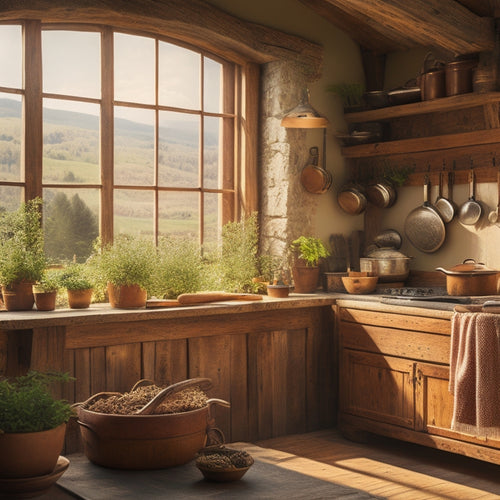
Essential Camp Kitchen Checklist for Adventurers
Share
A well-stocked camp kitchen is vital for a successful and enjoyable outdoor adventure, as it enables adventurers to prepare nutritious meals and snacks in the wilderness. Essential camping staples include salt, pepper, spices, and cooking oil/nonstick spray, which form the foundation of a versatile outdoor cooking setup. Non-perishable food and snacks, such as protein bars, trail mix, and canned goods, provide reliable sustenance in the wilderness. To customize your camp kitchen, prioritize lightweight, compact, and multi-use items aligned with your meal plan. By focusing on these essentials, you'll be well-prepared for your next adventure - and a few carefully considered additions can take your camp kitchen to the next level.
Key Takeaways
• Build a foundation with pantry staples like salt, pepper, spices, and cooking oil/nonstick spray for versatile outdoor cooking.
• Pack non-perishable food and snacks like emergency rations, trail mix, canned goods, energy bars, and peanut butter for reliable sustenance.
• Curate essential cooking equipment like pots, pans, utensils, and cookware that are fuel-efficient, durable, and lightweight.
• Tailor your camp kitchen to specific needs and preferences by creating a customized checklist with multi-use items for minimalist cooking.
• Prioritize non-perishable food items and snacks aligned with your meal plan to ensure a well-stocked and efficient camp kitchen.
Camping Essentials and Pantry Staples
A well-stocked camp kitchen begins with essential pantry staples, including salt, pepper, spices, and cooking oil/nonstick spray, which form the foundation of a versatile and adaptable outdoor cooking setup. These staples enable meal planning flexibility, allowing you to prepare a variety of dishes with ease.
In addition to pantry staples, cooking equipment such as pots, pans, utensils, and cookware are vital for preparing meals in the great outdoors. A well-organized camp kitchen also considers the type of cooking equipment needed, taking into account factors like fuel efficiency, durability, and weight.
Non-Perishable Food and Snacks
Beyond pantry staples, a well-stocked camp kitchen relies on non-perishable food and snacks that can withstand varying temperatures and humidity levels, providing a reliable source of sustenance in the wilderness. Emergency rations, such as protein bars, are essential for unexpected situations.
Trail mix, comprising nuts, seeds, and dried fruits, offers a convenient and nutritious snack. Dried fruits, like apricots, apples, and mangoes, provide a sweet and healthy option. Other non-perishable items include canned goods, energy bars, and peanut butter. These staples can be used to prepare meals or as standalone snacks.
When selecting non-perishable food and snacks, consider factors like shelf life, nutritional value, and personal preferences to guarantee a well-rounded and satisfying camp kitchen.
Customizing Your Camp Kitchen
To guarantee a seamless camping experience, tailor your camp kitchen to your specific needs and preferences by carefully curating the essential items and supplies. This process begins with personalized meal planning, where you consider your dietary requirements, cooking style, and the length of your trip.
By doing so, you can create a customized camp kitchen checklist that caters to your unique needs. For instance, if you're an advocate of minimalist cooking, focus on lightweight, compact, and multi-use items. Additionally, prioritize non-perishable food items and snacks that align with your meal plan.
Frequently Asked Questions
How Do I Keep My Camp Kitchen Organized and Clutter-Free?
To maintain a clutter-free camp kitchen, implement storage solutions like bins and baskets, and prioritize meal prep and cleanliness by assigning tasks, labeling gear, and establishing a 'clean as you go' policy to guarantee a smooth and efficient cooking experience.
What Are Some Healthy Meal Options for Camping With Kids?
"Savvy campers seeking healthy meals for kids can start with simple, satisfying snacks like fruit kebabs and trail mix, then delight in camping dessert ideas like banana boats and s'mores, all made with wholesome ingredients."
Can I Use a Portable Stove or Camping Grill in Windy Conditions?
When cooking in windy conditions, prioritize safety by anchoring your portable stove or camping grill securely, using windshields or shields to block gusts, and maintaining a safe distance from flammable materials to prevent accidents.
How Do I Prevent Cross-Contamination of Food and Utensils?
'In the wilderness, a perfect storm of bacteria and parasites lurks, threatening to spoil your culinary creations. Guarantee food safety and hygiene by implementing proper cleaning and storage protocols, separating raw and cooked foods, and designating utensils for each task.'
Are There Any Special Considerations for Camping With Food Allergies?
When camping with food allergies, prioritize planning by incorporating food allergy friendly recipes and packing allergy safe camping snacks, ensuring safe meal preparation and minimizing risk of allergic reactions in the wilderness.
Related Posts
-

Rustic Hanging Racks for Country-Style Kitchens
Rustic hanging racks are a game changer for your country-style kitchen, blending functionality with charm. They maxim...
-

Space-Efficient Dish Racks for Tiny Homes
Space-efficient dish racks are a game changer for tiny homes. By utilizing vertical storage, you can free up signific...
-

Corner Cabinet Storage for Dinnerware Sets
Corner cabinet storage for dinnerware sets can change your kitchen into an organized, stylish space. By utilizing ver...


